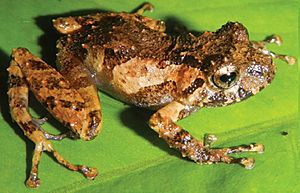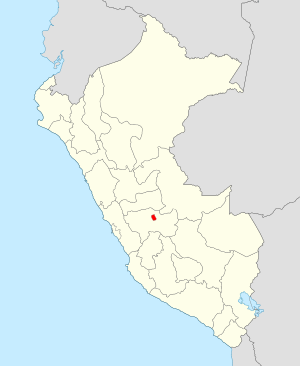Pristimantis ashaninka facts for kids
Quick facts for kids Pristimantis ashaninka |
|
|---|---|
 |
|
| Female | |
| Conservation status | |
| Scientific classification | |
 |
|
| In red, location of the Pui Pui Protection Forest |
The Pristimantis ashaninka is a special kind of frog that lives in the Pui Pui Protection Forest in central Peru. This frog is quite small, usually measuring about 23 to 26 millimeters long. That's about the size of a large paperclip!
What makes this frog unique? Its skin has tiny, pointy bumps called conical tubercles, which make it look a bit spiny. Also, it doesn't have an eardrum, which is unusual for a frog. Scientists officially described this species in 2017 after studying its body features and DNA. They named it Pristimantis ashaninka to honor the Asháninka people, who are an indigenous group living near the forest where the frog was found.
The International Union for Conservation of Nature (IUCN) has listed this frog as a least-concern species. This means it's not currently in danger of disappearing. We don't know much about how these frogs behave or reproduce yet. However, scientists believe their babies (called tadpoles) develop directly into tiny frogs without needing a water stage, which is common for frogs in the Pristimantis group.
Contents
Discovering the Ashaninka Frog
Scientists Edgar Lehr and Jiří Moravec first described this frog on January 12, 2017. They published their findings in a science magazine called ZooKeys.
How Scientists Found a New Species
To figure out if it was a new species, they compared it to other frogs. They looked at its body shape and size. They also did DNA tests. These tests showed that the frog was related to others in the Pristimantis group. But after many comparisons, they realized it was different enough to be a brand new species!
Naming the Frog
They decided to name it Pristimantis ashaninka to show respect for the Asháninka people. These indigenous communities live in the Peruvian regions of Huánuco, Junín, Pasco, and Ucayali, which are close to where the frog lives.
Where the Ashaninka Frog Lives

This special frog has only been found in one place so far: the northeastern part of the Pui Pui Protection Forest in Peru. This spot is about 18 kilometers from the city of Satipo.
The Frog's Home
The area where the frog lives is a valley with the Bravo river flowing through it. It's quite high up, between 1,700 and 1,800 meters above sea level. The valley is surrounded by tall mountains covered in old, untouched forests. These trees can be 15 to 20 meters tall! You can also find lots of bromeliads, ferns, and mosses growing there.
Climate and Neighbors
The weather in this forest is cool and damp, with temperatures usually between 6 and 15°C. Many different kinds of amphibians (like frogs) and reptiles live in this area. Some of them, like Attenborough's rubber frog (Pristimantis attenboroughi), have also been discovered recently.
Why It's Not Endangered
The International Union for Conservation of Nature (IUCN) says the Pristimantis ashaninka is a least-concern species. This is good news! It means there aren't any big threats to its home right now. The forest where it lives is protected, and scientists think there might be more of these frogs living in other parts of the forest that haven't been explored yet. With this discovery, Peru now has 130 known species in the Pristimantis frog group.
What the Ashaninka Frog Looks Like
| [[Image:{{{2}}}|{{{3}}}px|]] | [[Image:{{{4}}}|{{{5}}}px|]] | |
The Pristimantis ashaninka frog is typically between 23.1 and 26.7 millimeters long. Its head is a little bit narrower than its body, and its body is longer and wider.
Head and Face Features
This frog doesn't have a bony ridge on its head. Its snout (nose area) is fairly long and looks rounded from the side. The distance from its eye to its nostril is about 77% of the size of its eye. The nostril itself is on a small bump. The canthus rostralis, which is the ridge between its eye and snout, is quite long and rounded. The frog also has small bumps, called tubercles, on top of its eyelids. There's a small fold of skin above its eardrum area, but remember, it doesn't have an actual tympanic membrane (eardrum). Its choana (internal nostril opening) is small and oval-shaped.
Body Colors and Patterns
The frog's back has a large, reddish-brown spot shaped like an hourglass. This spot has creamy-brown edges. There are also two dark grayish-brown marks near its lower back (the sacral region) that outline the hourglass shape. The upper parts of its front legs are creamy brown, and its back legs are reddish-brown. The tips of its toes (called discs) are creamy brown. The frog's throat, chest, legs, and belly are grayish. Its eyes have a bronze color with tiny black spots.
Young Frogs vs. Adults
Male and female Pristimantis ashaninka frogs look very similar in color and pattern. However, young frogs and juveniles have some differences. Their skin bumps (tubercles) are more noticeable, and the skin on their backs is darker. The color of their throat can also vary from black to gray.
What Makes It Unique
This frog stands out from other frogs in its group because of a few key things:
- It has those spiny-looking tubercles on its back skin.
- It doesn't have an eardrum (tympanic membrane).
- It has those small black spots in its bronze-colored eyes.
While it looks similar to Pristimantis lirellus, Pristimantis martiae, and Pristimantis rhabdocnemus, the Pristimantis ashaninka is generally larger than these other species.
See also
 In Spanish: Rana cutín asháninka para niños
In Spanish: Rana cutín asháninka para niños


